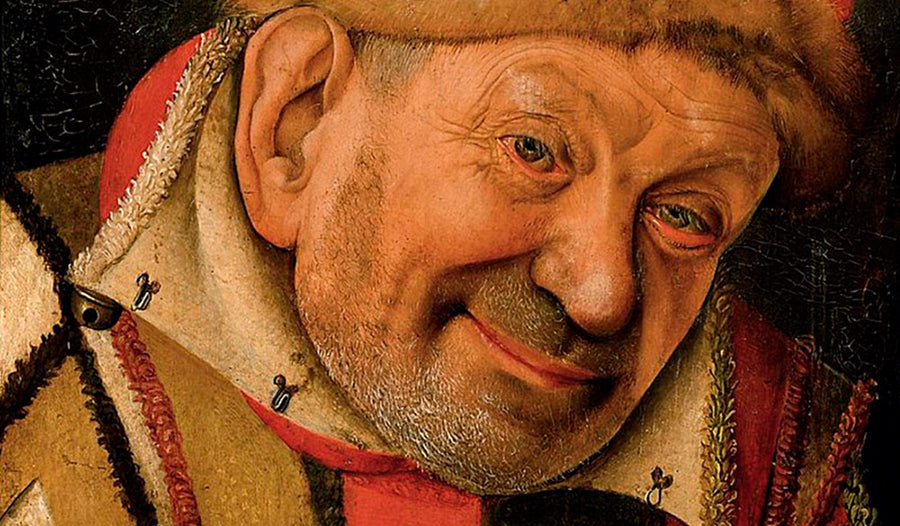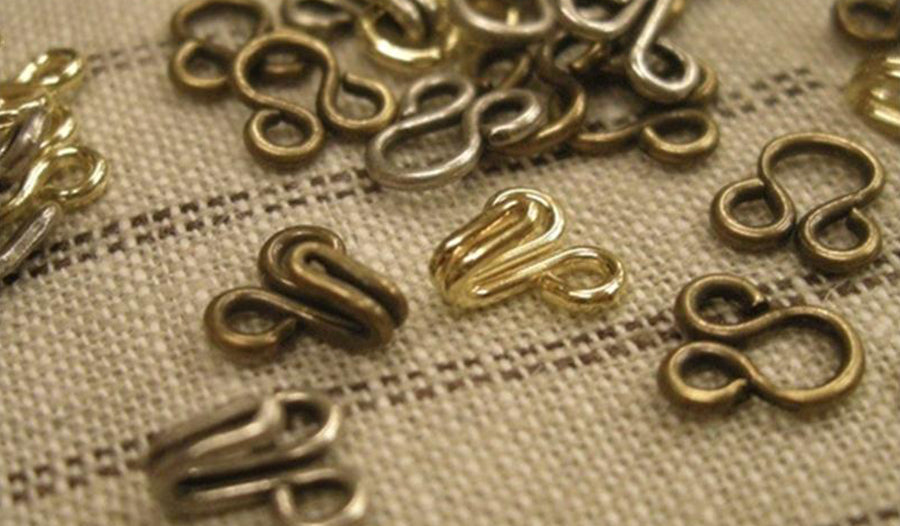
HOOKS AND EYES

When did hooks and eyes develop as a form of fastener for garments? This is the question that Gillian Vogelsang-Eastwood asked recently on the Textile Resource Centre Leiden regular blog. Read on for the full blog, or visit the TRC Leiden website here.
A few days ago the TRC in Leiden published a blog about pins and pin heads that were found in Zeeland, the Netherlands, and date to before 1532. The donation also includes several hooks and eyes. Essentially the hooks are made by using a length of wire with loops at each end, which is then folded in half, probably with pliers of some kind, into a long U-shape leaving the two loops next to each other at the top. The lower half of the U-shape was folded back on itself to create a hook.

Image: Two metal hooks from Zeeland, before 1532. Magnification: 15.2. Dino-Lite microscope (TRC 2021.2739a and b).
The eyes in the collection were made in three different ways, with (A) a wire circle with the ends twisted back on themselves (TRC 2021.2741c-f) and (B) a length of wire bent into a U-shape with small loops at each end (TRC 2021.2740a-e). A third type (C) is a combination of the two (TRC 2021.2741a-b). In addition to the hooks and eyes, the donation included several metal circles (TRC 2021.2744a-e), which may have been used as eyelets.
 Image: Two eyes with twisted ends, Zeeland, before 1532. Magnification 16.8 (TRC 2021.2741e-f).
Image: Two eyes with twisted ends, Zeeland, before 1532. Magnification 16.8 (TRC 2021.2741e-f).
These findings inevitably lead to the question, when exactly did hooks and eyes develop as a form of fastener for garments? A quick online search suggests that some believe that they are an American invention dating from the 19th century. However, if you dig a little bit deeper then it soon becomes clear the history of hooks and eyes is much older and can be traced back to the produce of artisans in medieval Europe.
 Image: Two eyes with simple loops at the ends, Zeeland, before 1532. Magnification: 17.2 (TRC 2021.2740a-b).
Image: Two eyes with simple loops at the ends, Zeeland, before 1532. Magnification: 17.2 (TRC 2021.2740a-b).
In the Dictionary of Fashion History, Valerie Cumming, Cecil W. Cunnington and Phillis E. Cunnington (2010:105) indicate that there is a 14th century written reference to a form of 'hooks and eyes' in England that were known as crochets and loops. Furthermore, by the early 16th century, according to various sources, hooks and eyes were made and used in various parts of Europe.
 Image: Two eyes with twisted and looped ends, Zeeland, before 1532. Magnification: 16.3 (TRC 2021.2741a-b).
Image: Two eyes with twisted and looped ends, Zeeland, before 1532. Magnification: 16.3 (TRC 2021.2741a-b).
In an earlier book by Cecil and Phillis Cunnington, called The History of Underwear (1992:20), there is a reference to a painting by the Flemish artist Pieter Brueghel the Elder (c. 1525-1569), The Old Shepherd, which is dated to about 1567. The portrait is of an old man who is wearing a linen shirt that is open at the collar to reveal two hooks and corresponding eyes.
 Image: Jean Fouquet, Portrait of the Ferrara Court Jester Gonella, c. 1445. Kunsthistorisches Museum, Vienna. Public domain.
Image: Jean Fouquet, Portrait of the Ferrara Court Jester Gonella, c. 1445. Kunsthistorisches Museum, Vienna. Public domain.
However, it would appear that the painting is not by Brueghel, but by the French painter, Jean Fouquet (c. 1420-1481), who worked for various royal and noble courts in Italy. It would seem that the portrait depicts Pietro Gonnella (c. 1390-1441), who was a jester at the court of the House of Este in Ferrara, in northern Italy. The portrait is now in the Kunsthistorisches Museum, Vienna and has been dated to c. 1445. As Gonnella died in 1441, it is not clear if the date should be a little earlier, or the portrait was made shortly after his death.
Hooks and eyes are also depicted in a painting by the Italian artist Franceso Bianchi (1447-1510) of the Crucifixion. The painting dates to 1490-1495. The Virgin Mary has fainted at the foot of the cross and her bodice is partially undone, as a symbol of distress and mourning. This artistic device has allowed Bianchi to show a line of hooks and eyes on the inside of her garment.
 Image: Francesco Bianchi, Crucifixion, c. 1490-95. Palazzo dei Musei (Modena). Public domain.
Image: Francesco Bianchi, Crucifixion, c. 1490-95. Palazzo dei Musei (Modena). Public domain.
What is clear from these two paintings is that the use of metal hooks, with either eyes or loops, can be dated to at least the mid-15th century and that their form is very similar to those found in Zeeland that date to before 1532, so about a hundred years later. It was not until the mid- to late 18th century that mechanically made hooks and eyes became available in Europe and took over the artisan role of the hook and eye maker.
--
Written by Gillian Vogelsang-Eastwood, Textile Resource Centre Leiden.
Read more content from the TRC blog here.

5 comments
WOW GREAT INVENTION
During my research for the Emmy nominated miniseries, “The Bastard“ at the Metropolitan Museum of Art in New York, I discovered American revolutionary dresses that had hooks and eyes down the center back. This was contrary to many beliefs because most of the dresses in the Europe were robes that closed at the front with lacing. Additionally they were hand made wire twisted together. Research revealed that they came from a Mercantile store in Boston. Apparently, the Couture in Europe had little influence on American dressmakers who made gowns similar to the ones in European style, although that was the last thing on these settlers minds.
I was overwhelmed to read this article, because it more than proves that, despite comments made that the costumes look inappropriate, because they had closures at the back, by several media pundits, claiming to have apparel backgrounds, they are indeed, historically accurate.
Wow. Amazing information. Thank you!!
Fascinating and amazing to find that these tiny closures were designed centuries ago. Many painting held in the National Portrait Gallery, London, have incredible details of cloth and textiles marking time with fashion in the painted portraits.
As an 18th century history fan its these tiny sometimes hidden details that bring the period to life. Thank you.